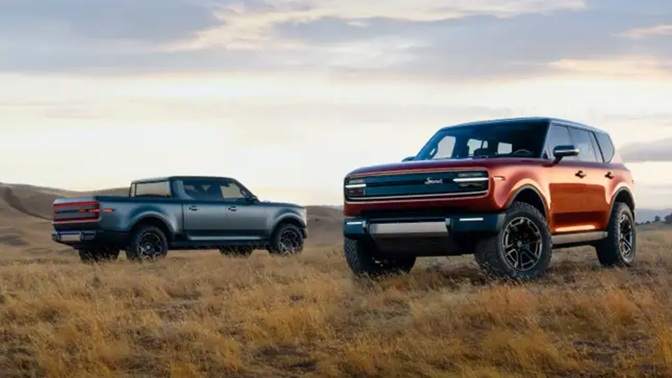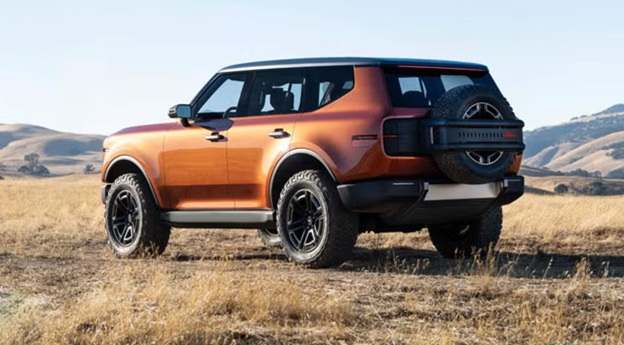The return of Scout Motors under Volkswagen is one of the most exciting developments in the U.S. electric vehicle (EV) market. While details have been limited, Scout has revealed a game-changing approach—offering both pure electric (BEV) and extended-range (EREV) versions of its upcoming vehicles. This bold move sets Scout apart from other brands and opens new possibilities for adventure-seeking drivers.

The Unique Dual Powertrain Approach
Unlike most automakers that focus solely on full-electric models, Scout Motors is taking a different path by introducing two distinct powertrain options:
- Battery Electric Vehicle (BEV) – A pure EV with a massive 120-130 kWh battery and an estimated 350-mile range per charge.
- Extended-Range Electric Vehicle (EREV) – Features a 60-70 kWh battery paired with a four-cylinder gas engine acting as a generator. This setup provides about 150 miles of electric driving before the engine kicks in, extending the total range to over 500 miles.
This EREV system, known as the “Harvester” range extender, is expected to be sourced from Volkswagen and will not use a turbocharger. Instead, it will be optimized for efficiency, making it ideal for those who need long-range capability without worrying about charging infrastructure.
Performance-wise, both versions of the Scout promise impressive specs, though the BEV will be the faster option.
| Feature | BEV (All-Electric) | EREV (Extended-Range) |
|---|---|---|
| Battery Size | 120-130 kWh | 60-70 kWh |
| Electric-Only Range | 350 miles | 150 miles |
| Total Range (with gas) | 350 miles | 500+ miles |
| 0-60 MPH | ~3.5 seconds | ~4.5 seconds |
| Power Output | Higher | Slightly lower |
| Battery Type | Likely Nickel Manganese Cobalt (NMC) | Likely Lithium Iron Phosphate (LFP) |
The pure EV version is expected to deliver quicker acceleration, making it a great choice for drivers seeking high-performance electric power. Meanwhile, the EREV model will trade some power for practicality, ensuring long-range travel without range anxiety.
Towing, Payload, & Capability
Both Scout EV and EREV will offer the same 2,000-pound payload capacity, making them versatile for work and adventure. While exact towing capacities haven’t been confirmed, it’s expected that the EREV model will be the better choice for long-distance towing, competing directly with trucks like the Ram 1500 Ramcharger.
This could be a game-changer, especially as the market for extended-range pickups remains largely untapped. Ram has already canceled its fully electric 1500 REV, prioritizing the range-extender model instead. This shift suggests a growing preference for trucks that balance electric efficiency with gas-powered backup.
To optimize performance, the Harvester range extender will come with at least three driving modes:
- EV Priority Mode – Uses battery power as much as possible, keeping the engine off.
- Hybrid Mode – Balances power from the battery and gas engine for efficiency.
- Engine Priority Mode – Uses the engine more frequently to preserve battery charge.
This flexibility allows drivers to adapt to different driving conditions, whether they’re off-roading, commuting, or towing heavy loads.

Local Production & Direct Sales Model
Scout Motors is investing heavily in U.S. manufacturing, with 85% of its supply chain based in America. This means less reliance on foreign imports and a higher chance of qualifying for the full $7,500 federal EV tax credit.
Production will take place at a $2 billion factory in South Carolina, which is expected to produce 200,000 vehicles annually starting in late 2027. Unlike traditional automakers, Scout aims to sell vehicles directly to customers, bypassing the dealership model. However, this strategy has often led to legal challenges, as dealership networks push back against direct-to-consumer sales.
One of the most surprising revelations from Scout’s CEO Scott Keogh is that over 50% of early reservations have been for the EREV (range extender) models. Additionally, 70% of reservations have been for the Traveller SUV, rather than the Terra pickup.
This strong demand for long-range hybrid-like trucks suggests that many drivers still value the flexibility of a gas-powered backup, despite the growing popularity of full-electric vehicles.
While Scout’s strategy is promising, there are a few challenges that could impact its success:
- Federal EV Tax Credit Uncertainty – If a Trump administration returns, there’s speculation that EV incentives could be eliminated before 2027, making Scout vehicles more expensive.
- Competition from Established Brands – Rivals like Ford, Tesla, and Rivian are already well-established in the EV truck market. Scout will need to differentiate itself through pricing, technology, and brand loyalty.
- Legal Issues with Direct Sales – Many states still require automakers to sell through dealerships. Scout may have to fight legal battles if it wants to avoid the traditional dealership model.
Scout Motors’ comeback is one of the most exciting developments in the electric truck and SUV space. By offering both pure EV and extended-range models, it caters to different types of drivers—from those seeking a high-performance electric vehicle to those needing a practical long-distance truck.
With up to 500 miles of range, a rugged off-road design, and flexible driving modes, Scout has the potential to shake up the market. However, challenges such as EV tax credits, dealership laws, and strong competition will determine just how successful this revived brand can be. For now, the future looks bright for Scout Motors, and we can’t wait to see these trucks hit the road!
Related Post
